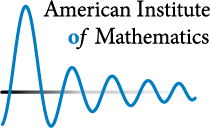1. Problems
Here are the problems discussed during the problem session.-
It is known that if $\dim A \leq 2$. The result is also true for some other varieties, such as $K3$ surfaces or ordinary cubic fourfolds. Look at Ogus, LN 900.
Problem 1.1.
[Y. Zahrin] Let $A$ be an abelian variety over a number field $K$. Does there exist a finite extension $K'/K$ such that for a set of primes $v$ of $K'$ of density $1$, $A/\F_v$ is ordinary? -
Ulmer conjectures that there is a bound. However, this result is false over finite fields.
Problem 1.2.
[D. Ulmer] Let $X/\mathbb C$ be a surface of general type. Then Lang’s conjecture implies that there exists a constant $N$, depending only on $X$, such that if $C \subseteq X$ is rational, then $K_X \cdot C \leq N$.
What happens if $X$ is an elliptic surface? Is there a bound on $K_X \cdot C$ as $C$ varies through rational curves? -
This result was proven by Elkies for $\dim A = 1$ over number fields $K$ with a real place. Poonen says that the supersingular part is probably false, since the supersingular locus in the moduli space of abelian varieties has codimension $>1$.
Problem 1.3.
[J. Achter] Let $K$ be a number field, and let $A/K$ be an abelian variety. Do there exist infinitely many places $v$ of $K$ such that the reduction $A/\F_v$ is not ordinary? More strongly, do there exist infinitely many places $v$ of $K$ such that the reduction $A/\F_v$ is supersingular? -
Problem 1.4.
[V. Vologodsky] (a) Let $K$ be an algebraically closed field, $X/K$ an abelian variety. The Voevodsky motive $F$ is given as a sheaf of groups $F(S) = \textrm{Mor}_K(S,X)$. Is $F$ geometric (i.e. in the triangulated subcategory generated by smooth projective varieties)?
(b) (This is a stronger variant of (a)): Is every principally polarized abelian variety a direct summand of a Jacobian integrally (as an abelian variety)? -
Problem 1.5.
[R. Pries] Let $p$ be a prime number. For a fixed dimension $g$ and a fixed $p$-rank $f$, what is the smallest field of definition of a simple abelian variety over $\overline{\F_p}$ with dimension $g$ and $p$-rank $f$? -
Ciliberto: Yes, if every surface $S$ of general type is birational to $S' \subseteq \mathbb P^3$, where $S'$ has only isolated singularities.
Problem 1.6.
[C. Voisin] Is every abelian variety the quotient of $\textrm{Jac}(C)$, where $C$ is a smooth plane curve? -
Voisin thinks the answer may be "no", by using the method of Esnault-Bloch.
Problem 1.7.
[C. Voisin] Let $X$ be a principally polarized abelian variety of dimension $\geq 4$. Is $\theta^2 \in CH^2(X)/\textrm{tors}$ divisible by $2$? -
OK if $\dim A = 2$, or if $K = \C$ and $A$ is a smooth projective variety.
Problem 1.8.
[H. Esnault] Let $A$ be an abelian variety over a finite field $K$, and $u: A \to A$ a fixed automorphism. Then $u$ induces $u^*: H^*(\overline{A}, \Q_l) \to H^*(\overline{A}, \Q_l)$. Let $\alpha_i$ be its eigenvalues, and let $|\alpha_i|$ denote the archimedean size of $\alpha_i$. Take the subring in $H^*(\overline{A}, \Q_l)$ generated by a polarization and stabilized by $u$. Is the maximum archimedean size of the eigenvalues of the subring equal to the maximum archimedean size of the eigenvalues of $H^*(\overline{A}, \Q_l)$?
Cite this as: AimPL: Cohomological methods in abelian varieties, available at http://aimpl.org/cohomabelian.
